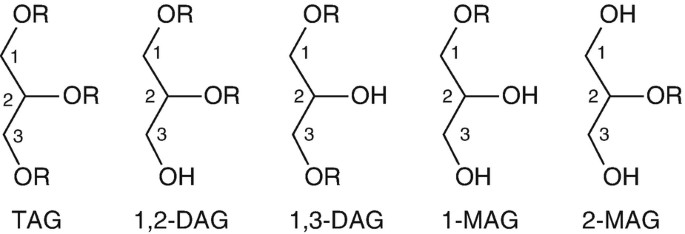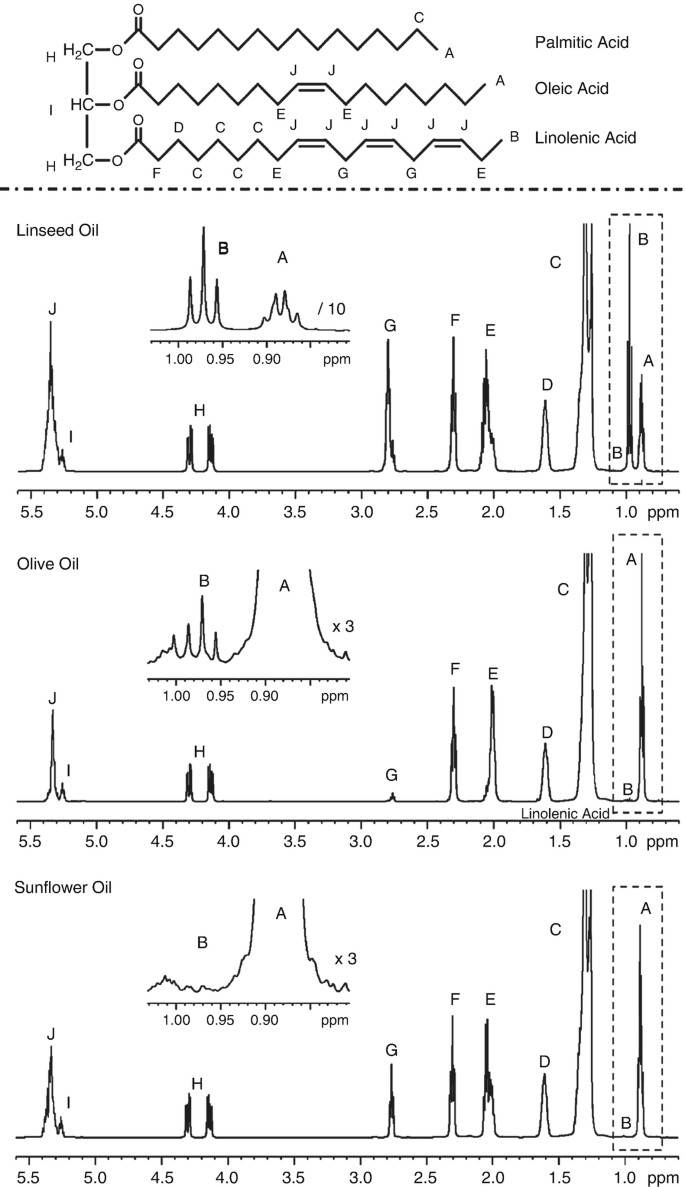Compositional and Quantitative Analysis of Oils and Lipids
NMR is an extremely powerful tool, which can be used not only for structural analysis and qualitative analysis, but also for quantitative composition analysis of compound mixtures. Edible oils and lipids are also examples of complex compounds. NMR has been used to study the composition of oils and lipids in detail.
As an expert in the field of nuclear magnetic resonance, Creative Biostructure provides quantitative analysis and identification services for oxidation products, sterols and other trace components, phospholipids, free fatty acids, and other components in oil.
 Figure 1. Chemical structures of triglycerides (TAG), diglycerides (DAG), and monoglycerides (MAG). (Lankhorst & Chang, 2018)
Figure 1. Chemical structures of triglycerides (TAG), diglycerides (DAG), and monoglycerides (MAG). (Lankhorst & Chang, 2018)
Determination of the Position Distribution of Fatty Acids on The Main Chain of Glycerol
13C NMR is a powerful method. We can determine the position distribution of different types of fatty acids on the main chain of glycerol according to the difference in chemical shifts observed on the carbonyl signal. The chemical shift of carbonyl signal first depends on the position of acyl group on the main chain of glycerol. When connected to C1 or C3 of glycerol, the carbonyl signal appears in the low field of the carbonyl signal of the acyl group connected on C2, about 0.4 ppm.
Identification and Quantitative Analysis of Oxidation Products
We usually use 1H NMR to identify and quantitatively analyze the oxidation products in the sample.
Lipid oxidation is carried out through free radical chain reaction. The first degradation product that can be observed in NMR spectrum, namely the so-called primary oxidation product, is hydroperoxide. The hydroperoxide (-OOH) signal is usually 8.3 to 8.9 ppm wide single-line, and the CH-OOH signal is 5.5 to 6.6 ppm multi-line. Hydrogen peroxide is degraded to aldehyde, which is the product of secondary oxidation. The signal of aldehyde was observed in the range of 9.3 - 9.9 ppm. Alkanols produce a triad, which distinguishes them from the 2-alkanol that produces the triad. In addition, diene, hydroxyenaldehyde and epoxy enaldehyde will generate high resolution signals with different chemical shifts.
Quantitative Analysis Services for Sterols and Other Trace Components
- Quantification of free and esterified sterols in olive oil.
- Quantification of sterols, diglycerides, monoglycerides and free fatty acids in coconut oil.
- Quantification of phenolic compounds in vegetable oils.
 Figure 2. 1H-NMR spectrum of olive, linseed, and sunflower oils with respective assignment of the signals of the glycerol unit and the fatty acid chains. (Lankhorst & Chang, 2018)
Figure 2. 1H-NMR spectrum of olive, linseed, and sunflower oils with respective assignment of the signals of the glycerol unit and the fatty acid chains. (Lankhorst & Chang, 2018)
Other Service Contents
| Service | Description |
|---|---|
| Quantitative analysis of phospholipids | We can detect and quantify phospholipids by 1H NMR or 31P NMR. The latter method has great advantages, that is, it has selectivity for phosphorous compounds, so it completely avoids interference with all other compounds in the mixture. |
| Quantitative analysis of free fatty acids | The level of free fatty acid is one of the parameters usually monitored by the petroleum industry for quality control purposes. We can detect and quantify free fatty acids in vegetable oil by 1H NMR and 13C NMR. |
| Quantitative analysis of triglycerides, diglycerides and monoglycerides | 13C NMR can be used to quantify the oil composition. The 13C NMR spectrum ranges from 0 to 230 ppm. Therefore, the resolution of this technology is superior. |
| NMR fatty acid composition | 1H NMR method |
Creative Biostructure is committed to providing high-quality NMR analysis services to advance the life sciences fields. If you have any questions or needs, please contact us and our customer service staff will help you the first time.
Ordering Process
Reference
- Lankhorst P P, Chang A N. The application of NMR in compositional and quantitative analysis of oils and lipids. Modern Magnetic Resonance. 2018: 1743-1764.

